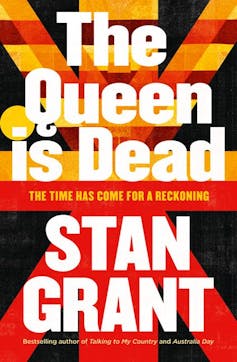how do we live with the weight of our history?
- Written by Heidi Norman, Professor, Faculty of Arts and Social Sciences, University of Technology Sydney

This month, journalist and public intellectual Stan Grant published his fifth book, The Queen is Dead[1]. And last week, he abruptly stepped away from his career in the public realm, citing[2] toxic racism enabled by social media, and betrayal on the part of his employer, the ABC.
“I was invited to contribute to the ABC’s coverage as part of a discussion about the legacy of the monarchy. I pointed out that the crown represents the invasion and theft of our land,” he wrote[3] last Friday. “I repeatedly said that these truths are spoken with love for the Australia we have never been.” And yet, “I have seen people in the media lie and distort my words. They have tried to depict me as hate filled”.
Grant has worked as a journalist in Australia for more than three decades: first on commercial current affairs – and until this week, as a main anchor at the ABC, where he was an international affairs analyst and the host of the panel discussion show Q+A. The former role reflects his global work, reporting from conflict zones with esteemed international broadcasters such as CNN. His second book, Talking to my Country[4], won the Walkley Book Award in 2016.
Review: The Queen is Dead – Stan Grant (HarperCollins)
In this new book, Grant yearns for a way to comprehend the forces, ideas and history that led to this cultural moment we inhabit. The book, which opens with him grappling with the monarchy and its legacy, is revealing in terms of his decision to step back from public life.
Released to coincide with the coronation[5] of the new English monarch, Charles III, The Queen is Dead seethes with rage and loathing – hatred even – at the ideas that have informed the logic and structure of modernity.
Grant’s work examines the ideas that explain the West and modernity – and his own place as an Indigenous person of this land, from Wiradjuri, Kamilaroi and Dharawal country. That is: his work explores both who he is in the world and the ideas that tell the story of the modern world. He finds the latter unable to account for him.
“This week, I have been reminded what it is to come from the other side of history,” he writes in the book’s opening pages. “History itself that is written as a hymn to whiteness […] written by the victors and often written in blood.”
He asks “how do we live with the weight of this history?” And he explains the questions that have dominated his thinking: what is whiteness[6], and what is it to live with catastrophe?
The death of the white queen
In his account, his rage is informed by the observation that the weight of this history was largely unexplored on the occasion of Queen Elizabeth II’s death last September. The death of the white queen is the touchpoint always returned to in this work – and the release of the book coincides with the apparently seamless transition to her heir, now King Charles III.

















